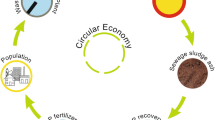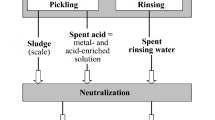Abstract
In this study, we designed and demonstrated the effectiveness of an integrated waste treatment system for contaminated stormwater sludge. The system is comprised of two components: pulsed arc electrohydraulic discharge (PAED) for aqueous-phase treatment and thermal plasma decontamination for solid-phase treatment. PAED provided a reduction of 80 % in total organic carbon (TOC) within a treatment time of 5 min in the aqueous phase. With a prolonged treatment of 30 min, the decontamination of TOC reached over 90 % in the aqueous phase, accompanied with 20 % carbon and 70 % sulfur decreases in weight in the solid phase. A huge weight reduction can be achieved prior to further solid treatment. The solid phase, named as the PAED-treated sludge, was separated by sedimentation and transferred to thermal plasma treatment. The thermal plasma-treated sludge was slightly melted, and the formation of slag was possible. X-ray energy dispersion solid analysis showed that carbon and sulfur were reduced to zero after treatment. Si, Mg, and Al decreased by 25, 30, and 60 %, respectively, while Ca and Fe enriched by 400 and 25 %, respectively. The emission gas analyses demonstrated a possible energy recovery from gaseous compounds with adequate gaseous treatment devices. This research demonstrates an innovative treatment approach of various sludge types, especially those types that contain high water contents and are severely contaminated by toxic organic compounds.







Similar content being viewed by others
References
Angeloni DM, Dickson SE, Emelko MB, Chang JS (2007) Removal of methyl-tert-butyl ether from water by a pulsed arc electrohydraulic discharge system. Jpn J Appl Phys 45:8290–8293
Ara M, Debacher N, Chang JS (2005) Formation of toxic gases by argon plasma torch operation in air environment. In: Proceedings of international symposium on the basic and application of plasma technology, pp 4–10
Arena U, Nelles M, Werther J (2012) Advanced aspects of thermal treatment of solid wastes: from a flue gas to a fuel gas technology. Waste Manag 32(4):623–624
Behera PK, Li JY, Adams BJ (2006) Runoff quality analysis of urban catchments with analytical probabilistics models. J Water Resour Plann Manag 132(1):4–14
Belgiorno V, De Feo G, Della Rocca C, Napoli RMA (2003) Energy from gasification of solid wastes. Waste Manag 23(1):1–15
Berge ND, Reinhart DR, Batarseh ES (2009) An assessment of bioreactor landfill costs and benefits. Waste Manag 29(5):1558–1567
Bernardo E, Dal Maschio R (2011) Glass-ceramics from vitrified sewage sludge pyrolysis residues and recycled glasses. Waste Manag 31(11):2245–2252
Beuthe TG, Chang JS (1997) Chemical kinetic modelling of non-equilibrium Ar-CO2 thermal plasmas. Jpn J Appl Phys 36:4997
Bian W, Ying X, Xhi J (2009) Enhanced degradation of p-chlorophenol in a novel pulsed high voltage discharge reactor. J Hazard Waste 162(2–3):906–912
Bishop CA, Struger J, Dunn L, Forder DR, Kok S (1997) Great lakes fact sheet: stormwater detention ponds of southern Ontario: are they a risk to wildlife. Authority of the Minster of Environment, Minister of Public Works and Government Services Canada
Bishop CA, Struger H, Shirose LJ, Dunn L, Campbell GD (2000) Contamination and wildlife communities in stormwater detention ponds in Guelph and the greater Toronto area, Ontario, 1997 and 1998. Part II-contamination and biological effects of contamination. Water Qual Res J Canada 35(3):437–474
Byun Y, Cho M, Chung JW, Namkung W, Lee HD, Jang SD, Kim YS, Lee JH, Lee CR, Hwang SM (2011) Hydrogen recovery from the thermal plasma gasification of solid waste. J Hazard Waste 190(1–3):317–323
Chang JS, Li OL, Guo Y (2008) Thermal plasma treatment of stormwater detention pond sludges. J Pure Appl Chem 80(9):1993–2002
Consonni S, Vigano F (2012) Waste gasification vs conventional waste-to-energy: a comparative evaluation of two commercial technologies. Waste Manag 32(4):653–666
Cox JH, Livingston EH (1997) Stormwater sediment: hazardous waste or dirty-dirt-an update. Proc Biennial Stormwater Res Conf 5:1–19
De la Torre A, Alonso E, Concejero MA, Sanz P, Martinez MA (2011) Sources and behaviour of polybrominated diphenyl ethers (PBDEs), polychlorinated dibenzo-p-dioxins and dibenzofurans (PCDD/Fs) in Spanish sewage sludge. Waste Manag 31(6):1277–1284
Duke LD, Buffleben M, Bauersachs LA (1998) Pollutants in storm water runoff from metal plating facilities, Los Angeles, California. Waste Manag 18(1):25–38
Gomez E, Amutha Rani D, Cheeseman CR, Deegan D, Wise M, Boccaccini AR (2009) Thermal plasma technology for the treatment of wastes: a critical review. J Hazard Mater 161(2–3):614–626
Graney JR, Eriksen TM (2004) Metals in pond sediment as archives of anthropogenic activities: a study in response to health concerns. Appl Geochem 19:1177–1188
Jones KW, Feng H, Stern EA, Lodge J, Clesceri NL (2001) Dredged material decontamination demonstration for the port of New York/New Jersey. J Hazard Mater 85(1–2):127
Karlsson K, Viklander M, Scholes L, Revitt M (2010) Heavy metal concentrations and toxicity in water and sediment from stormwater ponds and sedimentation tanks. J Hazard Mater 178(1–3):612–618
Lee L, Arnold AJ, Santillan CA, Emelko MB, Dickson S, Chang JS (2008) Bench-scale bacteria and viruses by pulsed arc electrohydraulic discharge disinfection. Water Qual Res J Canada 43(1):77–84
Lemmens B, Elslander H, Vanderreydt I, Peys K, Diels L, Oosterlinck M, Joos M (2007) Assessment of plasma gasification of high caloric waste streams. Waste Manag 27(11):1562–1569
Li OL, Guo Y, Chang JS (2011a) Toxic element analyses of summer and winter stormwater sediment by neutron activation analyses. J Environ Eng 138(5):588–593
Li OL, Chang JS, Guo Y (2011b) Pulsed arc electrohydraulic discharge characteristics, plasma parameters and optical emission of sludge-water. IEEE Electr Insul (EI) 27(2):8–17
Li OL, Takeuchi N, He ZH, Yasuoka K, Guo Y, Chang JS, Saito N (2012a) Active species generated by a pulsed arc electrohydraulic discharge plasma channel in contaminated water treatments. Plasma Chem Plasma Process 32(2):343–358
Li OL, Guo Y, Chang JS, Urashima K, Saito N (2012b) Treatment of non-point sources by a thermal plasma system under a DC partial transferred mode. Int J Plasma Environ Sci Technol 6(1):63–67
Li OL, Guo Y, Chang JS (2012c) Gaseous by-products from pulsed arc electrohydraulic discharge treatment of contaminated stormwater ponds. Int J Plasma Environ Sci Technol 6(1):1–8
Locke BR, Sato M, Sunka P, Hoffmann MR, Chang JS (2006) Electrohydraulic discharge and nonthermal plasma for water treatment. Ind Eng Chem Res 45:882–905
Lombardi L, Camevale E, Corti A (2012) Analysis of energy recovery potential using innovative technologies of waste gasification. Waste Manag 32(4):640–652
Marsalek J, Marsalek PM (1997) Characteristics of sediment from a stormwater management pond. Water Sci Technol 36(8–9):117–122
Marsalek J, Watt WE, Andersion BC, Jaskot C (1997) Physical and chemical characteristics of sediments from a stormwater management pond. Water Qual Res J Canada 32(1):89–100
McLaughlin D (1999) Evidence in virgo for the Universal Dark Matter Halo. Astrophys J 512:L9–L12
MOEE, Ministry of Environment, Ontario (1994) Stormwater management practices planning and design manual. Ontario
MOEE, Ontario Ministry of Environment (1993) Guidelines for the protection and management of aquatic sediment quality in Ontario, 0-7729-9248–7. Ministry of Environment, Toronto, Ontario, Canada
MOEE, Ontario Ministry of Environment (2003) Stormwater management practices planning and design manual. 4329e. Ministry of Environment, Toronto Ontario, Canada
Morrin S, Lettieri P, Chapman C, Mazzei L (2012) Two stage fluid bed-plasma gasification process for solid waste valorisation: technical review and preliminary thermodynamic modeling of sulphur emission. Waste Manag 32(4):676–684
Morris JWF, Barlaz MA (2011) A performance-based system for the long-term management of municipal waste landfills. Waste Manag 31(6):1109–1120
Moustakas K, Fatta D, Malamis S, Haralambous K, Loizidou M (2005) Demonstration plasma gasification/vitrification system for effective hazardous waste treatment. J Hazard Mater 123(1–3):120–126
Okochi NC, McMartin DW (2011) Laboratory investigations of stormwater remediation via slag: effects of metals on phosphorus removal. J Hazard Mater 187(1–3):250–257
Rienks J (1998) Comparison of results for chemical and thermal treatment of contaminated dredged sediment. Water Sci Technol 37:355–362
Rochfort Q, Grapentine L, Marsalek J, Brownlee B, Reynoldson T, Thompson S, Milani D, Logan C (2004) Using benthic assessment techniques to determine combined sewer overflow and stormwater impacts in the aquatic ecosystem. Water Qual Res J Can 35(3):365–397
Sakai S, Hiraoka M (2000) Municipal solid waste incinerator residue recycling by thermal processes. Waste Manag 20(2–3):249–258
Santiago R, Pelletier JP (2001) Contaminated sediment management: the Canadian experience. Water Qual Res J Can 36:395–411
Seadon JK (2006) Integrated waste management—looking beyond the solid waste horizon. Waste Manag 26:1327–1336
Shi J, Bian W, Yin X (2009) Organic contaminants removal by the technique of pulsed high-voltage discharge in water. J Hazard Mater 171(1–3):924–931
Urashima K, Chang JS (2000) Removal of volatile organic compounds from airstreams and industrial flue gases by non-thermal plasma technology. IEEE Trans Dielectr Electr Insul 7(5):602
Urashima K, Chang JS, Park JY, Lee DC, Chakrabarti A, Ito T (1998) Reduction of NOx from natural gas combustion flue gases by corona discharge radical injection techniques. Trans IEEE Ind Appl Soc 34:934
USEPA (2005) National management measures to control nonpoint source pollution from urban area, PA 841-B-05-004
Vel Leitner NKV, Syoen G, Romat H, Urashima K, Chang JS (2005) Generation of active entities by the pulsed arc electrohydraulic discharge system and application to removal of atrazine. Water Res 39:4705–4714
Yang SF, Wang TM, Lee WC, Sun KS, Tzeng CC (2010) Man-made vitreous fiber produced from incinerator ash using the thermal plasma technique and application as reinforcement in concrete. J Hazard Waste 182(1–3):191–196
Yantsis SN, Chow-Fraser P, Li OL, Guo Y, Chang JS, Terui S, Watanabe K, Itoh M (2008) Zooplankton mortality in lake water treated by pulsed arc electrohydraulic discharge plasma. Int J Plasma Environ Sci Technol 2(2):128–133
Zastawny HZ, Romat H, Karpel N, Leitner V, Chang JS (2004) Pulsed arc discharges for water treatment and disinfection. Electrostatics 137:325–330
Zhao P, Ni G, Jiang Y, Chen L, Chen M, Meng Y (2010) Destruction of inorganic municipal solid waste incinerator fly ash in a DC arc plasma furnace. J Hazard Mater 181(3–5):580–585
Acknowledgments
The authors would like to express their thanks and appreciations to Prof. J. S. Chang, who has contributed to this study greatly. He had passed away in February 2011 and it is great regret to not only the authors, but to the plasma research society. This research project is supported by the Natural Sciences and Engineering Research Council (NSERC) of Canada.
Author information
Authors and Affiliations
Corresponding author
Rights and permissions
About this article
Cite this article
Li, O.L., Guo, Y., Chang, J.S. et al. A new approach of nonpoint source pollution/stormwater sludge treatment by an integrated thermal plasma system. Int. J. Environ. Sci. Technol. 12, 1769–1778 (2015). https://doi.org/10.1007/s13762-014-0570-7
Received:
Revised:
Accepted:
Published:
Issue Date:
DOI: https://doi.org/10.1007/s13762-014-0570-7




